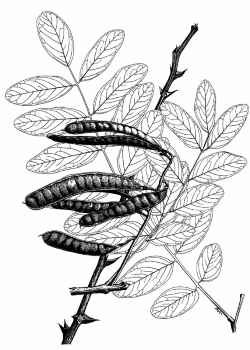Sunset®: All zones
USDA: 5-10
Sun Exposure: Full sun
Origin: Eastern United States
Growth Habits: Deciduous tree, rapidly growing to 40 to 60 feet tall (12-18 m) or more; trunk 12 to 30 inches in diameter (30-75 cm); thick bark with deep furrows; leaves 8 to 14 inches long (20-35 cm), with 7 to 19 leaflets, folding in the evenings
Flowers: White flowers
Watering Needs: Little to no water when established
Propagation: Seeds that keeps for many years, but need scarification or other treatment to breach their coat before they will germinate, root suckers, hardwood cuttings
Propagation: Seed or occasionally cutting, grafting/budding
- by cuttings.
- by side veneer graft, bench graftin grafts, in winter. Bench graftings stored at 65-70 degrees F for 10 days.
- by seeds, in spring. Germinates at 70-85 degrees F. The seeds can be harvested in autumn. The seeds need scarification. The usual germination temperature is 70-85 degrees F.
Blooming Habits:
The showy, aromatic, inflorescence is a large, pendant raceme, appearing in May or June. It is edible, I have seen it used for the preparation of delicious fritters. The flowers are creamy white.
Fruiting Habits:
The fruit is a brown flattened pod, 2 to 4 inches long (5-10 cm), ripening in September and October.
Desert-Tropicals is dedicated to provide gardening advice, gardening ideas, and information about flower of all kind for landscape and collections.We try to check carefully the identification of the plants on the illustrations as well as the other information from the page, but occasionally errors do occur. if you notice anything that needs to be changed please contact us.Thanks.
© 1998-2020 Philippe Faucon, All Rights Reserved.
